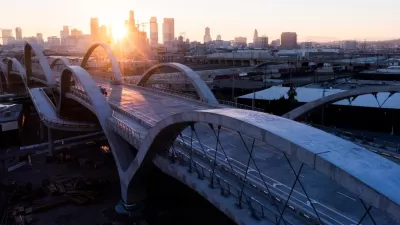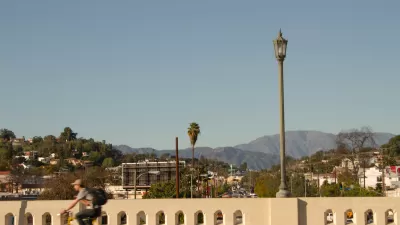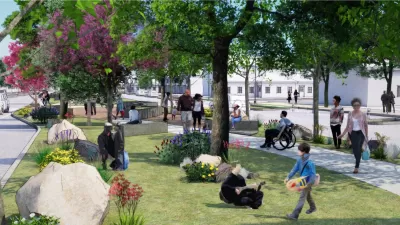Bike and pedestrian infrastructure on the much-anticipated new bridge leaves much to be desired, according to advocates.

“The brand-new 6th Street Bridge over the L.A. River, connecting Boyle Heights to the Arts District, was supposed to be a symbol of the city’s move away from a car-centric past and toward a future of more pedestrians and cyclists. It had been open for about a week before drivers plowed into not just one bike lane but both of them simultaneously,” writes Alissa Walker in Curbed.
Despite years of warnings from pedestrian and bike advocates and an ambitious early design, which included a separate level for pedestrians and cyclists, Walker argues that the bridge was not built to prevent such crashes or protect pedestrians and people on bikes. “There are four lanes of fast-moving traffic separated from its two bike lanes by plastic tubes mounted on rubber slabs screwed into the roadway more than a vehicle-width apart.” Additionally, “At either end, where the $588 million bridge touches back down to the grid, the walkways peter out into a narrow sidewalk with a single diagonal curb ramp and the barely protected bike lanes evaporate into sharrows, forcing cyclists to share vehicular lanes without any plastic between them at all.” After Monday’s crash, a bumper from one of the three cars involved still lay in the bike lane, forcing commuters to swerve around it.
Walker describes some “relatively easy fixes” the city could make to improve the as-yet-unfinished bridge: a median to prevent racing, dedicated bus lanes, K-rail barriers protecting the bike lanes. However, Walker opines that “the city almost certainly won’t make them,” focusing instead on civic events and film shoots—the latter of which will likely close the bridge to everyone during filming.
FULL STORY: A Bike Lane Built for a Car Crash

Planetizen Federal Action Tracker
A weekly monitor of how Trump’s orders and actions are impacting planners and planning in America.

Maui's Vacation Rental Debate Turns Ugly
Verbal attacks, misinformation campaigns and fistfights plague a high-stakes debate to convert thousands of vacation rentals into long-term housing.

San Francisco Suspends Traffic Calming Amidst Record Deaths
Citing “a challenging fiscal landscape,” the city will cease the program on the heels of 42 traffic deaths, including 24 pedestrians.

Defunct Pittsburgh Power Plant to Become Residential Tower
A decommissioned steam heat plant will be redeveloped into almost 100 affordable housing units.

Trump Prompts Restructuring of Transportation Research Board in “Unprecedented Overreach”
The TRB has eliminated more than half of its committees including those focused on climate, equity, and cities.

Amtrak Rolls Out New Orleans to Alabama “Mardi Gras” Train
The new service will operate morning and evening departures between Mobile and New Orleans.
Urban Design for Planners 1: Software Tools
This six-course series explores essential urban design concepts using open source software and equips planners with the tools they need to participate fully in the urban design process.
Planning for Universal Design
Learn the tools for implementing Universal Design in planning regulations.
Heyer Gruel & Associates PA
JM Goldson LLC
Custer County Colorado
City of Camden Redevelopment Agency
City of Astoria
Transportation Research & Education Center (TREC) at Portland State University
Jefferson Parish Government
Camden Redevelopment Agency
City of Claremont





























